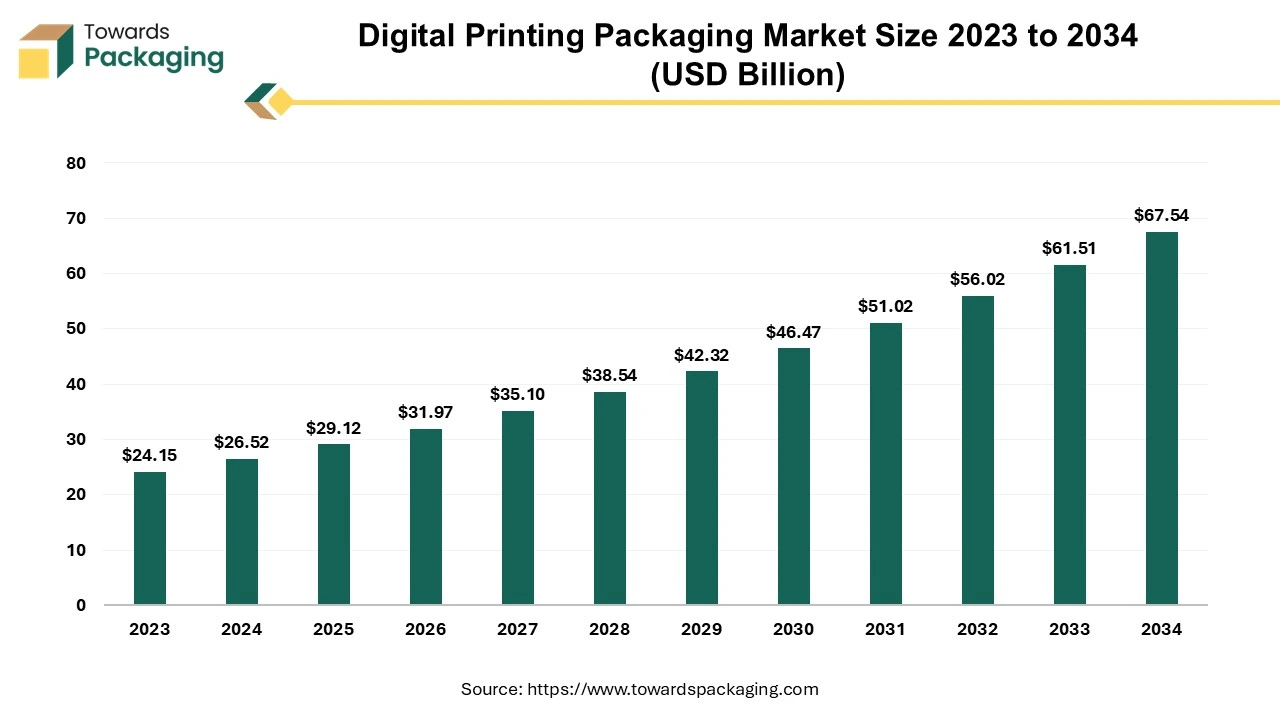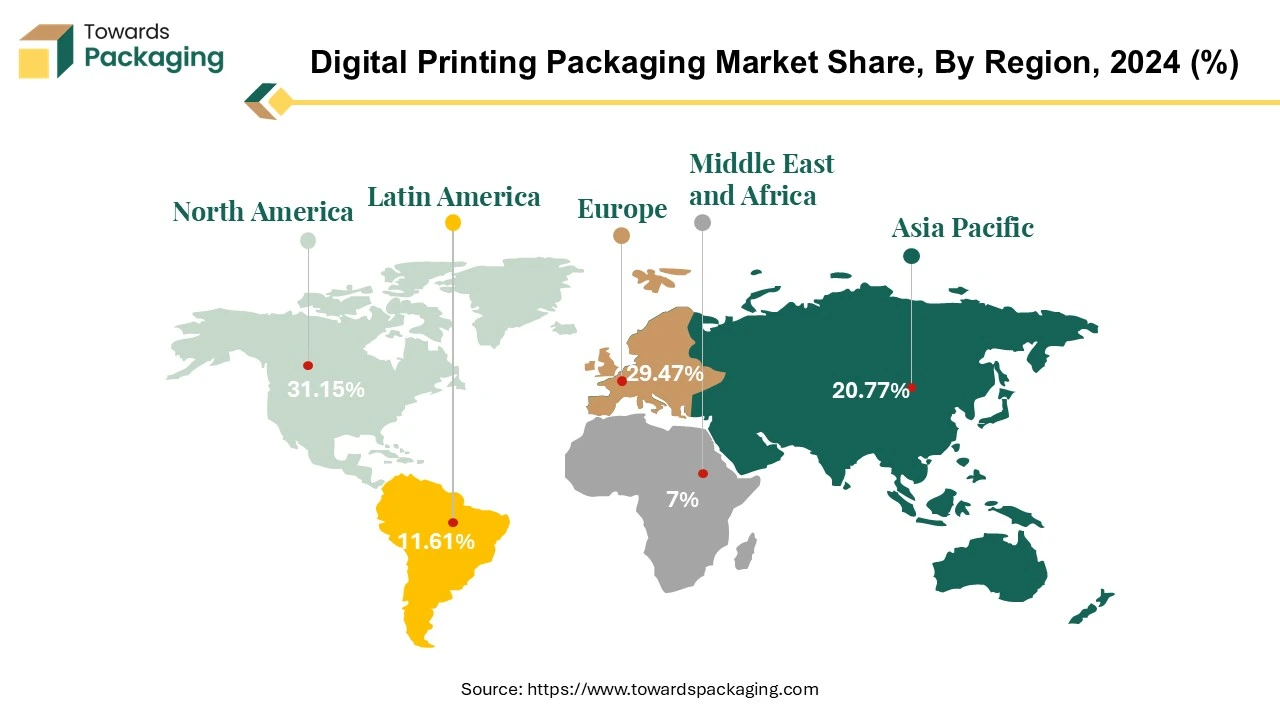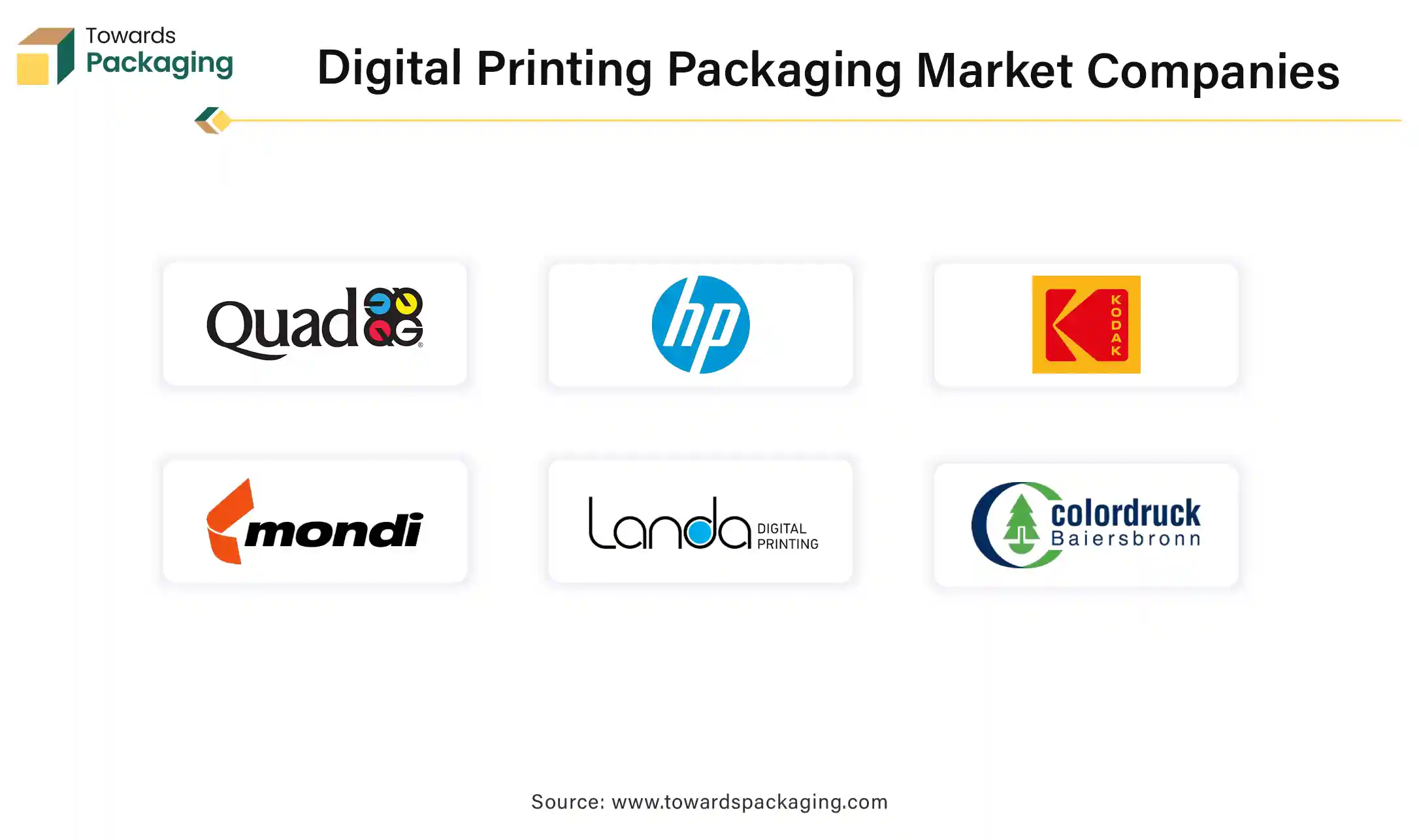The digital printing packaging market is forecasted to expand from USD 31.97 billion in 2026 to USD 74.17 billion by 2035, growing at a CAGR of 9.8% from 2026 to 2035. This market covers various segments, including printing technologies like inkjet, electrophotography, and thermal transfer printing. Regionally, North America leads the market with a share of 31.15%, followed by Europe and Asia Pacific, driving innovation and adoption.
Competitive analysis includes major players such as Quad/Graphics Inc., HP Inc., and Mondi Group, contributing to ongoing industry advancements and technological growth.

Digital printing in packaging involves the direct transfer of a digital file, typically a PDF or JPEG, directly to a printer to apply designs or information onto packaging materials. The segment of the packaging industry that utilizes digital printing technologies for creating packaging materials. In this context, digital printing involves the direct printing of digital-based images onto various packaging substrates such as paper, cardboard, plastic, and others. This approach differs from traditional printing methods like offset and flexography, offering advantages such as shorter print runs, customization capabilities, and quicker turnaround times.
In recent years, digital printing has experienced a substantial surge in popularity, driven primarily by automation and digitalization trends observed across various industries. This growth in the digital print market is particularly evident as packaging converters increasingly embrace digital printing technologies to enhance operational efficiencies and meet evolving consumer demands. Digital print accounts for 16.2% of the value of the global printing market. Notably, despite the rising prominence of digital printing, flexo and litho systems continue to dominate the market, mainly due to the current limitations of digital technology in supporting long print runs.
Challenges persist for digital technology providers, especially in developing economically viable solutions without compromising on key factors such as quality, productivity, and format. While digital printing holds immense potential, several issues require attention, including the cost of ink, printing speed, and equipment constraints. However, advancements in technology are expected to address these concerns over time.
Despite the promising trajectory of digital printing, there are lingering challenges. High-volume printing capabilities are not yet at a satisfactory stage, and color reproduction in digital printing differs from conventional methods, potentially leading to branding issues. Premium features such as metallic embellishments and textured lacquers are not readily available, and certain finishing processes like embossing, cutting & creasing face limitations or are challenging to deploy in the digital printing realm. These issues notwithstanding, ongoing technological developments are likely to contribute to the resolution of these challenges, making digital printing an increasingly viable and competitive option in the packaging industry.
| Metric | Details |
| Market Size in 2025 | USD 29.12 Billion |
| Projected Market Size in 2035 | USD 74.17 Billion |
| CAGR (2026 - 2035) | 9.8% |
| Leading Region | North America |
| Market Segmentation | By Printing Technology, By Packaging, By End User and By Region |
| Top Key Players | Quad/Graphics Inc., HP Inc., Eastman Kodak Company, Mondi Group, Landa Corporation Ltd. |
| Manufacturer | Market Share (%) |
| Amcor Plc | 7.8 |
| Berry Global Inc. | 6.9 |
| Sonoco Products Co. | 5.1 |
| Sealed Air Corp. | 3.6 |
| Huhtamaki Oyj | 3.1 |
| Pactiv Evergreen | 4 |
| Sabert Corp. | 0.9 |
| Placon Corp. | 0.4 |
| D&W Fine Pack | 0.35 |
| Anchor Packaging | 0.3 |
| Supplier | EBITDA (%) |
| Amcor Plc | 18.8 |
| Berry Global Inc. | 17.5 |
| Sonoco Products Co. | 16.2 |
| Sealed Air Corp. | 15 |
| Huhtamaki Oyj | 14.5 |
| Pactiv Evergreen | 13 |
| Sabert Corp. | 12.5 |
| Placon Corp. | 12 |
| D&W Fine Pack | 11.8 |
| Anchor Packaging | 11.5 |
The digital printing packaging market has emerged as a leader in North America, driven by a confluence of regional, technical, and economic advantages that have significantly influenced its growth trajectory. The unique dynamics of the North American market, coupled with the advanced technological landscape and robust economic conditions, have positioned digital printing as a preferred choice for packaging solutions across various industries.
North America's leadership in the digital printing packaging market is underscored by its vast and diverse consumer landscape. The region encompasses a wide array of industries, including food and beverage, pharmaceuticals, consumer goods, and more, each with distinct packaging needs. The ability of digital printing to offer customization at scale aligns perfectly with the diverse product portfolios and branding strategies prevalent in North America. This adaptability has allowed digital printing to carve out a significant market share, addressing the specific requirements of different sectors within the region. Through 2025, U.S. e-commerce revenues are projected to increase at a CAGR of 9.5%.

North America boasts a mature and well-established packaging industry infrastructure. The presence of numerous packaging converters and industry players, combined with a robust supply chain, has facilitated the seamless integration of digital printing technologies. This has created an environment conducive to innovation and rapid adoption, further solidifying North America's leadership position in the digital printing packaging market.
The technical prowess of digital printing technologies has played a pivotal role in its dominance in the North American packaging landscape. The region has been at the forefront of adopting and advancing digital printing capabilities, leveraging cutting-edge technologies to enhance print quality, color accuracy, and overall efficiency. The continuous evolution of digital printing has addressed historical challenges such as speed, enabling it to compete with traditional printing methods like flexography and lithography.
The North American market has witnessed substantial investments in research and development, fostering the creation of high-performance digital printing solutions tailored to the demands of the packaging industry. This technical innovation has not only improved the capabilities of digital printing but has also expanded its applicability to a broader range of packaging materials, meeting the diverse needs of North American businesses.
The emphasis on sustainability and eco-friendly practices in North America has propelled the adoption of digital printing. Its ability to support sustainable initiatives, reduce waste, and use recycled materials aligns with the growing environmental consciousness of both businesses and consumers. This alignment with sustainable practices has given digital printing a competitive edge, especially in a market where corporate social responsibility and environmental considerations are integral to brand positioning.
The digital printing packaging market is rapidly emerging in Europe, marked by a convergence of regional, technical, and economic advantages that significantly influence its growth trajectory. Europe's unique market dynamics and a commitment to innovation and sustainability have propelled the adoption of digital printing technologies in the packaging sector.
Europe's diverse and expansive market serves as a catalyst for the growth of digital printing in packaging. The region encompasses a myriad of industries, including pharmaceuticals, cosmetics, food, and beverage, and more. The demand for customized and visually striking packaging solutions aligns seamlessly with the capabilities of digital printing. The ability to cater to various product types and branding strategies positions digital printing as a versatile solution for the diverse European market.
The European printing market is predicted to grow in the future and reach US$174.2 billion by 2027. This indicates that digital printing could emerge as the dominant trend in the printing business in the post-epidemic age. Europe's emphasis on quality and design aesthetics aligns with the precision and flexibility offered by digital printing. The cultural importance placed on aesthetics and branding creates an environment where the unique capabilities of digital printing can thrive, meeting the expectations of both businesses and consumers.
Europe has been at the forefront of technical advancements in digital printing, fostering innovation in print quality, color management, and substrate compatibility. The region's focus on research and development has led to the creation of advanced digital printing solutions that address the evolving needs of the packaging industry. These technical advancements contribute to the increased adoption of digital printing, enabling it to compete with traditional printing methods.
The European market's openness to embracing new technologies has facilitated the seamless integration of digital printing into existing packaging workflows. The continuous evolution of digital printing technologies ensures that it remains a viable and attractive option for businesses looking to enhance their packaging capabilities in line with European standards of quality and sophistication. Economically, Europe's commitment to sustainability and environmental responsibility has played a pivotal role in driving the adoption of digital printing in packaging. The region's stringent environmental regulations and consumer preferences for eco-friendly packaging have positioned digital printing as a sustainable and environmentally conscious solution. Digital printing's ability to reduce waste, use recycled materials, and support on-demand production aligns with Europe's sustainability goals, making it an increasingly preferred choice for businesses looking to meet both economic and environmental objectives.
Digital printing has revolutionized the packaging industry, and labels are no exception to this transformative trend. In the dynamic landscape of the digital printing packaging market, labels play a crucial role in conveying essential information, enhancing brand visibility, and providing a platform for creative and dynamic design. The adoption of digital printing technologies for labels brings forth a myriad of advantages that cater to the evolving needs of both brands and consumers.
One of the key advantages of digital label printing is its ability to accommodate shorter print runs without compromising on quality. Traditional printing methods often required large quantities to justify cost-effectiveness, but digital printing allows for more flexible production. This agility is particularly beneficial for niche products, limited editions, or seasonal variations, enabling brands to respond swiftly to market demands and consumer preferences.
Customization is another hallmark of digital label printing. Brands can personalize labels with variable data, such as individualized content, images, or even QR codes. This level of customization enhances consumer engagement and facilitates targeted marketing strategies. Whether it's a unique message for a specific demographic or the incorporation of interactive elements, digital label printing empowers brands to create a more tailored and memorable consumer experience.
In the global digital printing packaging market, the label segment continues to witness innovations in materials and finishes. Digital printing allows for the use of a diverse range of substrates, opening up possibilities for unique textures, colors, and embellishments. This flexibility in material selection contributes to the overall aesthetics of the product and reinforces brand identity.
Moreover, digital label printing aligns seamlessly with sustainability goals. The technology minimizes waste by enabling on-demand printing and reducing the need for excessive prepress setups. Additionally, the use of eco-friendly inks and materials in digital printing supports environmentally conscious packaging initiatives.
Inkjet printing excels in producing high-resolution and detailed prints, making it suitable for intricate designs, logos, and text on packaging materials. This capability is crucial for meeting the quality standards demanded by brands and consumers. Inkjet printing is versatile and can accommodate a wide range of substrates, including paper, cardboard, plastics, and even certain specialty materials. This versatility allows for flexibility in packaging design and material choices. The ability to customize and personalize packaging is a key driver of inkjet printing demand. Brands can create unique and targeted packaging designs for different products, promotions, or customer segments, enhancing consumer engagement and loyalty.
Inkjet technology allows for cost-effective short print runs and on-demand printing. This is particularly advantageous in the packaging industry where brands may require smaller quantities for limited editions, seasonal promotions, or niche products without incurring excessive costs. Inkjet printing excels in variable data printing, allowing for the incorporation of unique information, such as barcodes, QR codes, or personalized messages on each package. This is valuable for supply chain management, traceability, and consumer engagement. Inkjet printing is known for its fast turnaround times. The technology allows for quick setup and printing, making it suitable for meeting tight production schedules and responding promptly to market demands.
Inkjet printing can be cost-effective, especially for short to medium print runs. The elimination of traditional printing plates and the ability to print directly from digital files reduce setup costs and waste, making it an economically viable solution. Inkjet printing is often considered more environmentally friendly than traditional printing methods. Ongoing advancements in inkjet technology, including improvements in ink formulations and printhead technology, contribute to enhanced print quality, color accuracy, and the ability to handle a broader range of substrates.
The high global demand for inkjet printing in the digital printing packaging market is driven by its ability to deliver high-quality, versatile, and customizable packaging solutions. The technology's flexibility in accommodating various substrates, cost-effectiveness for short print runs, and environmental considerations contribute to its widespread adoption across diverse industries within the packaging sector.
Digital printing in the food and beverage sector has become a strategic and impactful solution, offering numerous advantages that cater to the specific needs of this industry. Digital printing allows food and beverage companies to customize packaging with intricate designs, branding elements, and personalized content. This capability is crucial for creating unique packaging that aligns with brand identity, promotes new products, and engages consumers on a personal level.The food and beverage sector often requires packaging for limited-time promotions, seasonal variations, or niche products. Digital printing's ability to accommodate short print runs cost-effectively enables companies to respond quickly to market demands, reducing the need for excess inventory and minimizing waste.
Digital printing technology excels in variable data printing, enabling the inclusion of specific information such as nutritional facts, expiration dates, or promotional codes on each package. This is essential for compliance with regulations, enhancing traceability, and providing consumers with accurate and relevant information. In a fast-paced industry like food and beverage, rapid response to market trends is crucial. Digital printing's quick setup and production times allow companies to bring new products to market faster, capitalize on timely promotions, and adapt packaging designs swiftly to changing consumer preferences. Maintaining a consistent brand image across various products is essential for brand recognition and loyalty. Digital printing ensures color consistency and precise reproduction of logos and brand elements, contributing to a cohesive and recognizable brand identity on store shelves.
The food and beverage sector often requires high-quality graphics to showcase product details, attract consumer attention, and communicate product quality. Digital printing's capability to produce vibrant, photo-realistic images enhances the visual appeal of packaging, contributing to a positive consumer perception. Compliance with food safety and labeling regulations is paramount in the food and beverage industry. Digital printing allows for accurate and compliant label printing, ensuring that packaging meets legal requirements and provides consumers with the necessary information about the products they consume. As sustainability becomes a focal point for consumers and businesses alike, digital printing in the food and beverage sector offers eco-friendly options. It minimizes material waste, allows for the use of recycled and sustainable substrates, and supports environmentally conscious packaging practices. In a crowded market, standing out is essential. Digital printing enables food and beverage companies to differentiate their products through innovative packaging designs, seasonal variations, and limited-edition releases. This differentiation contributes to increased consumer interest and brand loyalty.
Digital printing has revolutionized packaging in the food and beverage sector by providing flexibility, customization, and efficiency. As consumer preferences and industry trends continue to evolve, digital printing will play an integral role in helping companies navigate the dynamic landscape of the food and beverage market.
The digital printing packaging market is characterizing characterized competition among key industry players, including Quad/Graphics Inc., HP Inc., Eastman Kodak Company, Mondi Plc., Landa Corporation Ltd., Reynders Label Printing, Tailored Label Products Inc., Traco Manufacturing Inc., Thimm Group, Elanders, Colordruck Baiersbronn, WS Packaging Group Inc.. These entities are making significant investments in manufacturing Ddgital printing packaging solutions. Notably, industry leaders are adopting inorganic growth strategies such as acquisitions, mergers, partnerships, and collaborations to augment their product portfolios, thereby contributing to the global expansion of the digital printing packaging market.

By Printing Technology
By Packaging
By End User
By Region
December 2025
December 2025
December 2025
December 2025